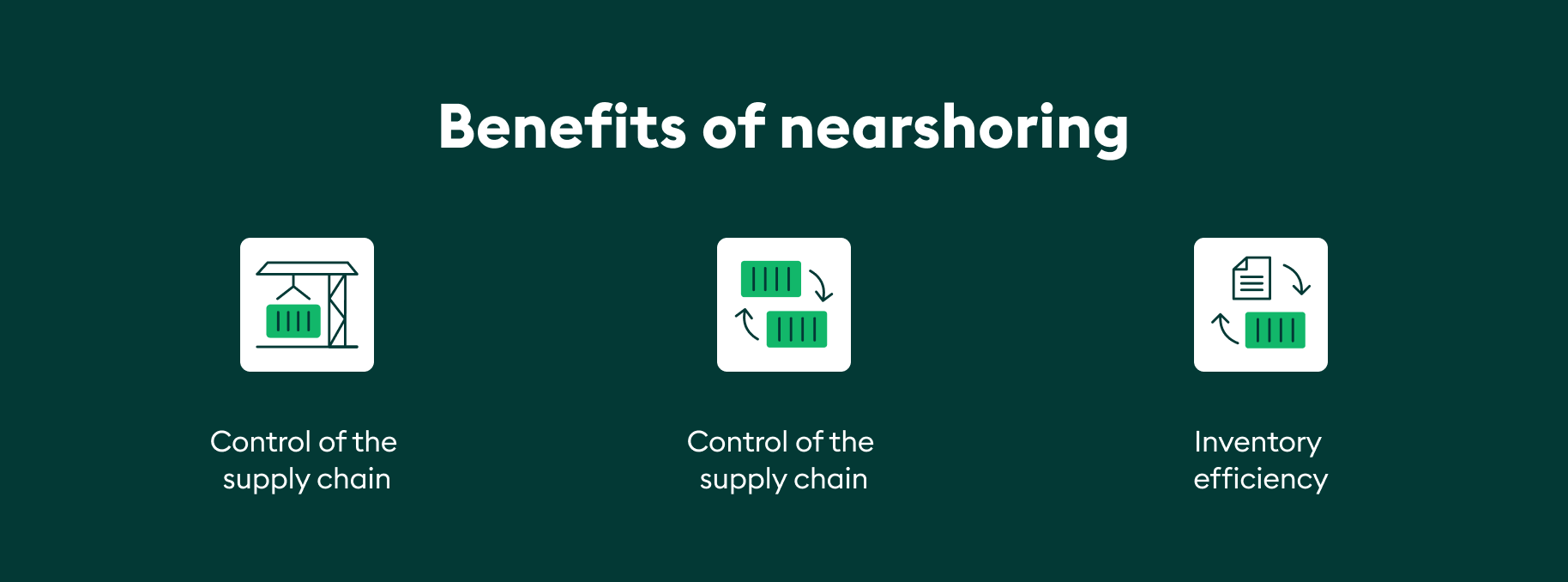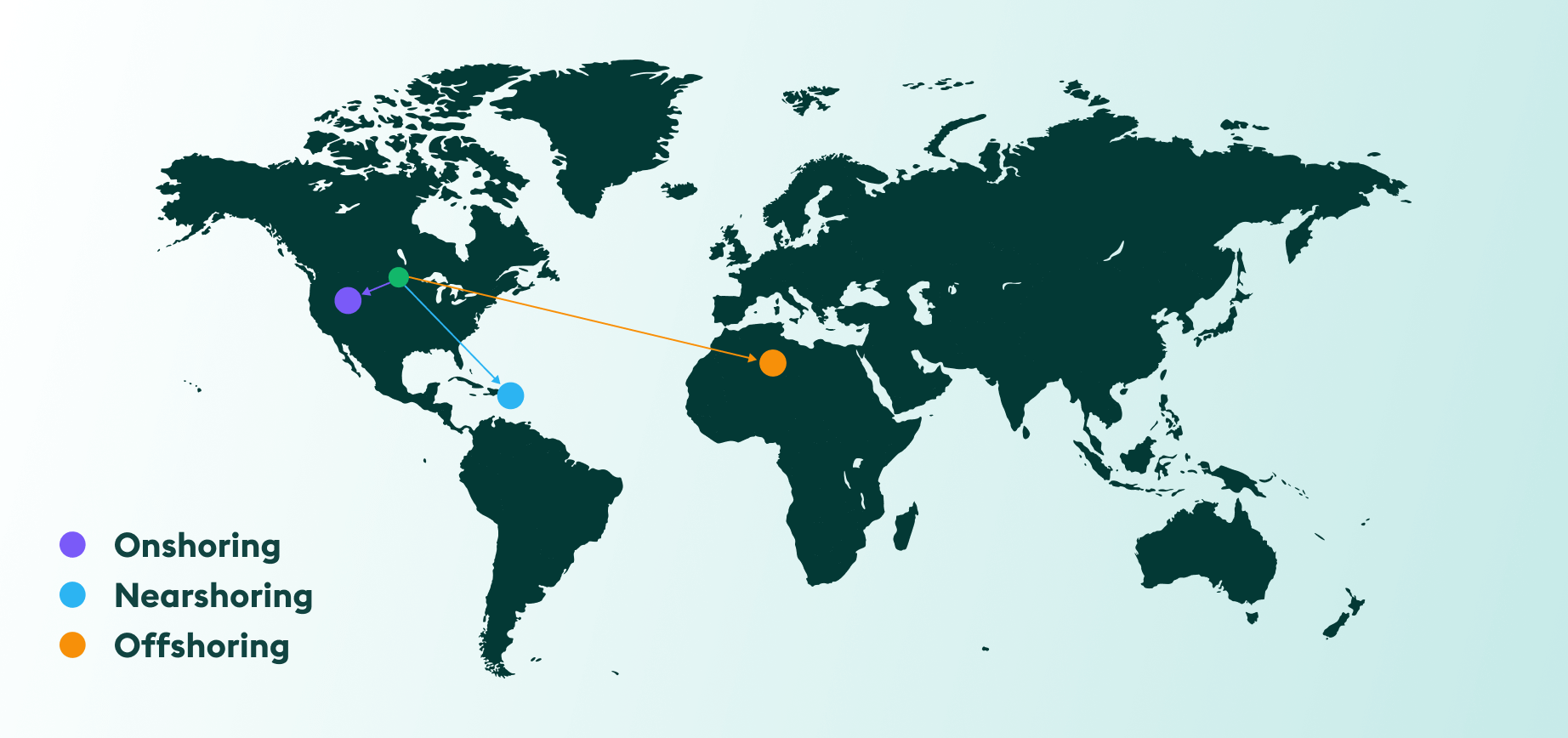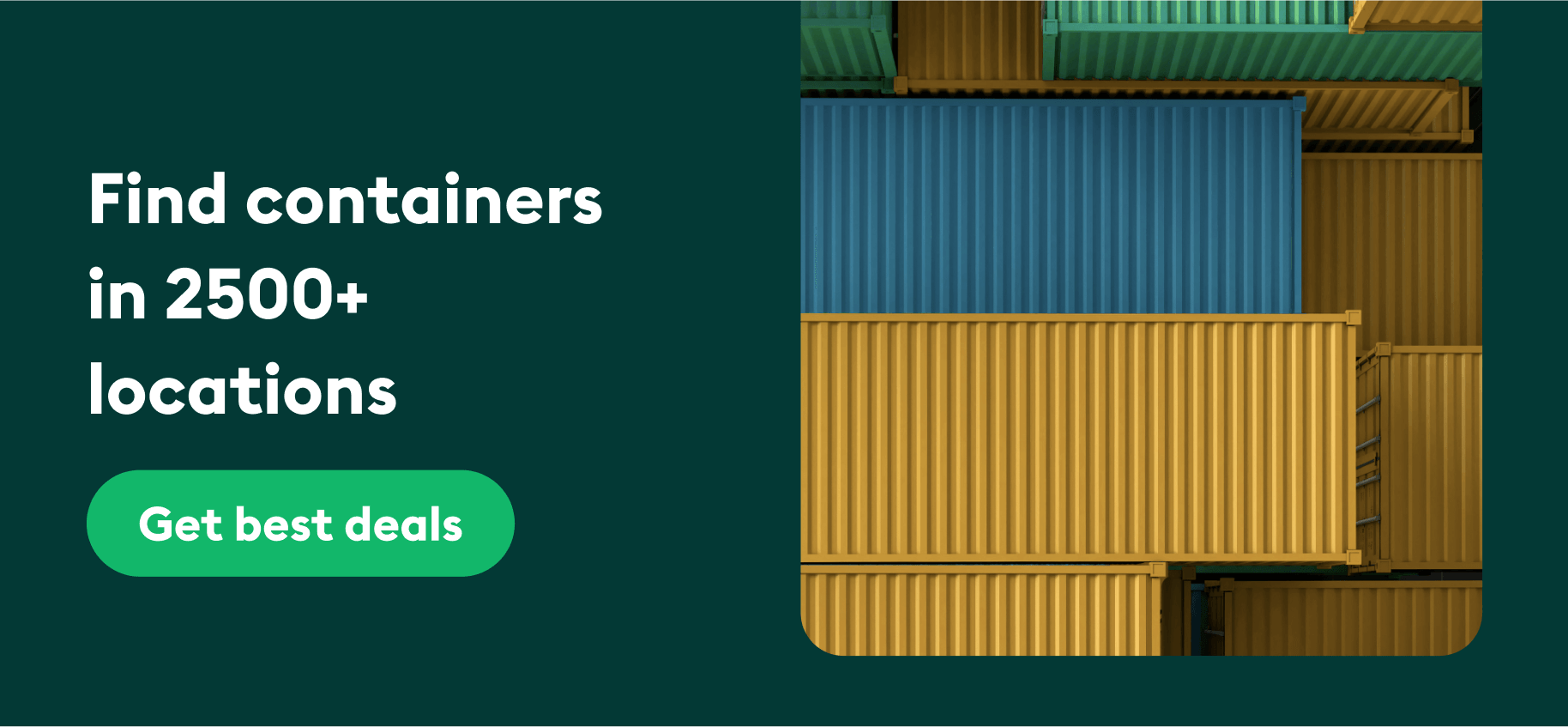Many companies have started to opt for nearshoring in the supply chain in recent years. Read this blog to find out what nearshoring is, its benefits and how it is different from other outsourcing practices. Also, learn how you can source quality containers in 2,500+ locations globally.
Since 2020, many macro events have contributed to reveal the fragility of the global supply-chain. This includes the Covid-19 pandemic, the Russia-Ukraine war and growing geopolitical tensions between the US and China.
Supply chain leaders and businesses are exploring several options to build more resilient supply chains and one practice that has gained popularity is nearshoring. We’ll talk more about nearshoring further in the blog.
But if your business is also considering starting or shifting its operations to new locations, you must secure a steady container supply. This will ensure that your goods reach their destination on time.
However, it can be difficult to find trustworthy container suppliers in new locations. This is where Container xChange can help you. On our platform, you can connect with 1,500+ vetted container suppliers in 2,500+ locations globally. All our members go through a vetting process, so you don’t have to spend time doing a background check yourself.
Just use the public search below and fill in your requirements like container type and location. Then, browse through multiple offers from vetted sellers and choose the best container deals for your business — even in new locations!
What is Nearshoring in supply chain?
Nearshoring in the supply chain refers to the practice of outsourcing business processes or services to companies located in neighboring countries. Typically, with a shared border or within the same time zone. For example, a US- based company may partner with a supplier in Canada or Mexico instead of China.
We’ll discuss more of these examples in detail later in the blog. But first, let’s look at why companies are opting for nearshoring and its benefits.
What are the benefits of nearshoring?
Nearshoring is becoming more popular among businesses because it offers several advantages. Let’s take a look at these benefits.
Control of the supply chain
Nearshoring allows your business to have better control over the supply chain. It minimizes risks associated with geopolitical instability. Your company will be less exposed to significant political and economic fluctuations in neighboring regions – as compared to more distant outsourcing destinations. This stability contributes to a more predictable supply chain.
Moreover, nearshoring makes it possible to predict transportation times for goods. Even if the global disruption puts air and ocean shipments to a halt, your company won’t be severely affected. This is because you will be able to move the goods via land.
Reduces cycle times
Nearshoring enables shorter transportation time for your goods, reducing the cycle times and helping companies bring products to the market faster. Getting the goods from one place to another will take a shorter amount of time as it won’t take 6-8 weeks anymore. Reduced cycle times are particularly advantageous if your industry has rapidly changing customer demands.
Inventory efficiency
Since nearshoring reduces the cycle times, it also leads to inventory efficiency. Nearshoring allows for quicker delivery, helping you maintain lower inventory levels since you can order items closer to when you actually need them.
Moreover, when your suppliers are nearby, you can work closely with them to better understand their production schedules and capabilities. This improves your ability to forecast demand accurately, reducing the chances of ordering too much or too little inventory.

Let’s understand the benefits of nearshoring better through an example. Read on to find out more.
Nearshoring Case Study: Barbie-parent company Mattel moves to Mexico
In recent years, many companies in the US have started opting for nearshoring because of the benefits.
One such company is Mattel, Inc., an American multinational toy manufacturing and entertainment company. Mattel announced in March 2023 that it had spent around a billion pesos, or $50 million, to expand a plant in the northern Mexican state of Nuevo Leon. It is now the company’s largest plant, overtaking other hubs in China, Vietnam and Malaysia. Mattel will now be making its top-selling toys like Mega Bloks in Mexico.
Mattel’s move was just the latest instance of how worries about over-extended supply global chains are generating fresh interest in nearshoring from different industries.
Apart from Mattle, several other companies like Unilever and Dana Inc., announced they were expanding or building export factories in Mexico. As the US’ fastest-growing trade partner, Latin America has gained popularity as the hub for nearshoring initiatives. Read on to find more.
Nearshoring in Mexico
As part of the nearshoring initiatives, the US is likely to look to allies that are geographically close and politically aligned. This is mainly due to trade tensions, supply-chain difficulties and geopolitical concerns that push the US farther from China.
Mexico is emerging as an attractive investment location for businesses in the US. Along with its obvious geographical advantages, Mexico offers a large, low-cost labor force and free-trade agreements with the US and Europe. The country’s manufacturing clusters also offer concentrated areas of skilled workers, advanced industry-specific technology and an established knowledge base.
Even though many companies are considering nearshoring, you should consider all types of outsourcing strategies to make informed decisions for your business. Let’s take a look at them in the next section.
Nearshoring vs Offshoring: What is the difference?
Offshoring is a business strategy that includes moving business operations to a more distant location. This strategy involves taking advantage of the lower labor and manufacturing costs. Offshoring also allows access to certain raw materials and skills.
For example, Nike, an American athletic footwear and apparel corporation, has offshored its manufacturing units to Asia. For fiscal 2022, Nike reported that the contract factories in Vietnam, Indonesia and China manufactured approximately 44%, 30%, and 20% of total Nike Brand footwear, respectively.
While offshoring can offer significant cost savings for your business, it can also come with certain risks. This includes quality control issues, communication challenges and supply chain disruptions. With growing geopolitical tensions across the globe, many companies are considering friendshoring over offshoring. Read on to find out more.
Nearshoring vs Friendshoring
Friendshoring, or allyshoring, is a new concept in which countries source raw materials and manufactured goods from other countries that share their economic and political values. This concept was first mentioned by US Secretary of the Treasury, Janet Yellen in a speech at the Atlantic Council in April, 2022.
Some benefits of friendshoring for your business include improved quality of goods, reliability and long-term partnership with other businesses. This is because geopolitical tensions wouldn’t disrupt the supply chain in friendshoring as well.
To understand friendshoring better, let’s take a look at how Apple is diversifying its production bases. Read on to find out more.
Friendshoring Case Study: How China Plus One Strategy diversifies supply chain
China-Plus-One, or just Plus One, refers to a strategy in which companies avoid investing only in China and diversify their businesses to alternative destinations. This approach became popular due to various factors:
- Geopolitical uncertainties
- Rising costs in China
- The desire to mitigate risks associated with over-dependence on a single production base.
Tech giant Apple is one American company to have recently made friendshoring moves, relocating some of its iPhone production to India from China. This is in line with the China Plus One Strategy to secure crucial supply chains strained by Covid lockdowns and rising geopolitical tension.
Currently, only 5% of Apple products are made outside of China, but a recent JP Morgan analysis suggests this could rise up to a quarter by 2025.
If you’re considering any of these strategies for your business, it’s important to secure a steady supply of containers in these new locations to ensure your goods reach their destination safely.
However, the container market is known for its lack of transparency. It can get difficult to find vetted container suppliers selling you containers at the right prices in new locations.
This is where the Container xChange platform can help you. On our platform, you can connect directly with 1,500+ suppliers in 2,500+ locations. All our members go through a mandatory vetting process before joining the platform.
You can simply type in your container requirements and browse available offers. You can then compare the prices of multiple offers at the same time to make sure you’re getting the best deal. Want to check out offers in your preferred location? Click the banner below to get started.
Nearshoring vs Reshoring
Reshoring is bringing manufacturing and production services back to the country or region in which the company operates. It’s also known as inshoring or onshoring.
Companies may consider reshoring due to the fragility of global supply chains or more favorable trade policies in the home country. The main goal of reshoring is to help companies regain control over the end-to-end supply chain.
In the late 2000s, Ford, a US-based auto company, outsourced much of its production to countries such as Mexico and China to cut costs. However, by the 2010s, the company had begun to experience rising labor and shipping costs and other disruptions to its supply chain. In response, Ford started reshoring manufacturing back to the US, opening new factories and hiring new workers.
And now, according to 2022 data from S&P Global Mobility, Ford Motor Co. has solidified its position as America’s top automaker. This is in terms of vehicles assembled, vehicles exported to other countries, and hourly auto workers employed in America.

Even though nearshoring has been beneficial for many businesses in the US, nearshoring isn’t for everyone. If you’re considering nearshoring, read on to find out if it’s the right decision for your business.
Is nearshoring right for your business?
We’ve already seen that nearshoring has several benefits. However, before taking this approach, you must consider the risks and obstacles that come along with it. Here are a few things to consider.
-Switching costs: Switching costs are an important factor to consider before your business takes on nearshoring initiatives. These costs include expenses related to setting up new infrastructure, training employees in the new location, and adapting processes to the new environment. These upfront costs can be significant and may affect your budgeting and financial planning.
-Nearshoring at scale can take years: The larger the scale of nearshoring, the more complex the process becomes. Coordinating and transferring numerous processes, teams, and resources requires meticulous planning and execution, which takes time. In fact, it can take many years before your company shifts its entire operations to another country without disrupting your day-to-day business activities.
-Diversifying supply chains: If your company’s goal is to reduce dependency on one single country, you may consider diversifying your supply chains instead of nearshoring. China Plus One is a great example of how businesses are shifting their operations to other Asian countries instead of bringing the operations back to their home countries.
If you’re exploring ways to diversify your supply chain to new locations, one of the most important factors to look into is the supply of shipping containers in the new location. Afterall, around 90% of global trade is carried out via the ocean.
Read on to find out how you can ensure a steady container supply for your business even in new locations.
How to ensure steady container supply for your business in new locations
Securing a steady container supply is crucial for your business. And one easy way to do this is through the Container xChange platform. On our platform, you can connect with 1,500+ vetted container suppliers in 2,500+ locations globally. You can buy, sell or lease containers at 100% price transparency.
Read on to find out how easy it is to get your hands on the container you need on xChange.
Buy shipping containers
If you’re looking to use shipping containers for a long time, buying them would be most suitable for you. Whether you’re looking for standard shipping containers, specialized containers, or even storage solutions, our platform has you covered.
On our trading platform, you can find 12 types of shipping containers in different conditions. We have 50,000+ containers available – making it easier to find the container you’re looking for on xChange than your current sourcing channel. All you have to do is fill in your container requirements, and your location and browse through multiple offers from vetted sellers.
You can then negotiate directly and buy containers at best prices – even in new locations!
Lease shipping containers
If you’re looking for a more cost-effective solution, you can lease shipping containers instead. Leasing containers is perfect for short-term use and provides the flexibility to adjust your container fleet based on changing demand. You can easily scale up or down without the commitment of owning containers.
On our leasing platform, you can lease shipping containers for one-way in 2,500+ locations globally. You can find new reliable suppliers for new routes. The process of leasing containers is simple. All you have to do is fill in your pick-up and drop-off locations. You can then browse through the deals and choose the best one.
Whether you’re leasing or buying, Container xChange has got you covered. Here are some other benefits of using xChange over your traditional sourcing methods.
- Risk-free deals with vetted partners
- 100% secure transactions
- Price transparency
- 50,000+ containers to choose from in over 2,500 locations worldwide
- Secure payments
- 0% commission on all deals
You get all this right from your computer screen. Want to know more about our platform and how it can benefit your business? Simply click the banner below to get started.
Nearshoring in supply chain: Common FAQs
What is nearshoring?
Nearshoring in supply chain refers to the practice of outsourcing business processes or services to companies located in neighboring countries.
What is an example of nearshoring?
A good example of nearshoring would be a company based in the United States moving it’s manufacturing units from China to Mexico.
What is the difference between nearshoring and offshoring?
Nearshoring refers to the practice of outsourcing business processes to companies located in neighboring countries. Whereas offshoring refers to moving business operations to a more distant location.




